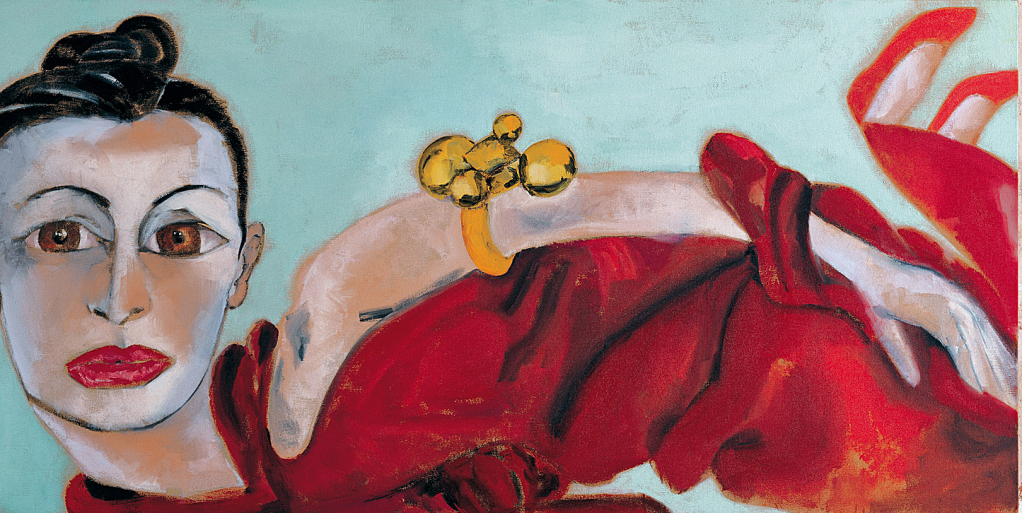Clemente
02.15.2000 - 06.04.2000
This exhibition-the first comprehensive museum retrospective of Francesco Clemente's oeuvre-charts over twenty-five years of the artist's career. Since the 1970s Clemente has produced a rich and complex body of work. His expressive portrayal of the human body and use of traditional materials departed radically from the Conceptualist aesthetic that dominated the late 1960s and 1970s. In addition, his itinerant sensibility, continuously traveling to and from Italy, India, and New York, as well as the American Southwest and the Caribbean, has had a demonstrated effect on his work, as the unique cultures of each locale have stimulated him, diversifying his imagery.
Clemente was born in Naples, Italy, in 1952. The cosmopolitan tradition of the city, and his early schooling in Latin and Greek, influenced his aesthetic and intellectual sensibility. In 1970, he moved to Rome to study architecture, against the backdrop of the social, political, and economic upheavals that transformed Italian society after 1968. His friends and mentors during this period included Alighiero Boetti and Luigi Ontani, as well as Joseph Beuys and Cy Twombly.
Since 1973, Clemente has spent part of each year in India, finding an affinity with the country's heterogenous culture. Drawing from India's mystical heritage and contemporary arts, he found the freedom to work simultaneously with various subject matter and mediums. In 1980, at the Venice Biennale, Clemente's diverse imagery commanded international attention and contributed to the international revival of Expressionism at the time.
In 1981, drawn to New York's ethnic and cultural diversity, Clemente moved to the city permanently with his wife and children. The 1980s in New York were marked by a strong esprit de corps among the worlds of art, poetry, avant-garde theater and film, fashion, and popular music. Distanced from the orthodoxy of European historicism and invigorated by the exchange of creative energy with his new friends and colleagues, the artist rapidly expanded the scope of his work. He produced his first large-scale oil paintings in the winter of 1981-82, began an open-ended series of portraits of visitors to his studio, and participated in numerous collaborative projects, working with Jean-Michel Basquiat and Andy Warhol on a group of paintings, and illustrating poetry by Robert Creeley, Allen Ginsberg, John Wieners, among others.
Eschewing any hierarchy of medium, Clemente has used oil, watercolor, ink, pastel, fresco, and sculpture interchangeably, engaging a wide range of cultural traditions and stylistic sources. Regarding his eclectic output, the artist has said: "Certain constellations of work[s] are formed even at a distance of years; the same format, the same technique, the same subject, the same images that the technique evokes. If you were to show my work chronologically, you would have a discontinuous representation since the same formats disappear for years and then return, then disappear and then return again."
In keeping with the artist's aesthetic development, the exhibition is organized thematically rather than chronologically. More poetic than categorical, the themes open several paths into Clemente's unique cosmology and initiate the viewer into a personal journey through the artist's work:
"I" reveals that, for Clemente, the self is not a distinct, but a permeable entity with borders that shift in encounters with other things, cultures, and people. This blurring of identity is particularly evident in the watercolor Alba and Francesco (1982), in which husband and wife dissolve into one superimposed image. The works in "Unborn" evoke the paradoxical nature of Clemente's art, which has the ability to recall simultaneously both past and present, man and woman, East and West, the spiritual and the physical, abstraction and figuration. "Bestiary" draws upon a series of medieval books that explored the moral and spiritual significance of animals. Revealing his belief in the equal importance of all orders of life, Clemente has developed a body of work, in which the human and animal realms, seemingly so separate, are often merged into unique forms. "Conversion to Her" explores the presence of diverse human sexuality explicitly portrayed in Clemente's oeuvre. The works in "Amulets and Prayers" were all created in India and demonstrate Clemente's interest in the elements, numbers and signs, alchemy, and the five senses, which the artist imbues with personal significance. "Books, Palimpsests, and Collaborations" explores Clemente's openness to collaboration, specifically his connection with the world of poetry. "Sky" is a compendium of imagery revealing Clemente's natural impulse to synthesize when faced with a wide variety of cultures and experiences. Finally, "Rooms" recalls Renaissance stanze (rooms), in particular the interiors of del Cossa and Mantegna, which provide refuge from the outside world. The four spaces that make up "Rooms" house frescoes, an environment titled The Indigo Room (1983-84), The Fourteen Stations (1981-82), and La Stanza della Madre. Exploring such subjects as the family and the Empedoclean philosophy of the four elements, the latter room was designed specifically for Gallery 203 as a commission for the inauguration of the Guggenheim Museum Bilbao in 1997.
Francesco Clemente
Alba, 1997
Oil on linen
116.8 x 233.7 cm
Collection of Francesco and Alba Clemente, New York

